
INTRODUCTION TO FRAME DATA
Frames are a measure of time. Most fighting games in recent years, including Tekken 7, run at 60 frames per second. Frame data tells us the speed of moves in the game in various aspects: how long they take to hit the opponent, how much of an advantage/disadvantage the player gets after the move successfully connects/is blocked and much more.
When two players in a match are both moving around without using any attacks, they are in neutral frames, meaning neither player is at a frame advantage or disadvantage. When a move is used, the attacker will then be at neutral frames (0), plus (+) frames (frame advantage) or minus (-) frames (frame disadvantage) depending on the move's properties. To demonstrate this more clearly, we will use Kazumi and Heihachi Mishima as examples.
Plus and minus frames
Every move in Tekken gives the player plus frames, neutral frames or minus frames on block, on hit and on counter hit (hitting the opponent while they are also attacking). A move that is plus on block means that after the move is blocked, the attacker will be at a frame advantage, meaning that their move will come out before the opponent's move if both decide to attack afterwards. Conversely, a move that is minus on block means that the opponent's move will come out before the attacker's, while a move that is 0 on block means the attacker and opponent's moves will come out at the same time. The same principles, further explained below, apply to moves on hit and on counter hit.
Before illustrating these situations, it is worth knowing that in most cases, a character's fastest move is 10 frames (i10), meaning the move takes 10 frames (or one sixth of a second) to connect with the opponent. In Tekken 7, the exceptions to this rule are Master Raven and Ling Xiaoyu, whose fastest moves are i8, as well as Geese (i9) and Yoshimitsu (i6).
To illustrate plus, minus and neutral frames on block, we will use the three attacks below from Heihachi's move list.
-
Heihachi's 1 is +1 on block. This means that if blocked, any follow-up move will come out 1 frame before Kazumi's move (in this and the next 2 cases, both are following up with i10 moves).

-
Heihachi's 1, 2 is -1 on block. This means that if blocked, any follow-up move will come out 1 frame after Kazumi's move.
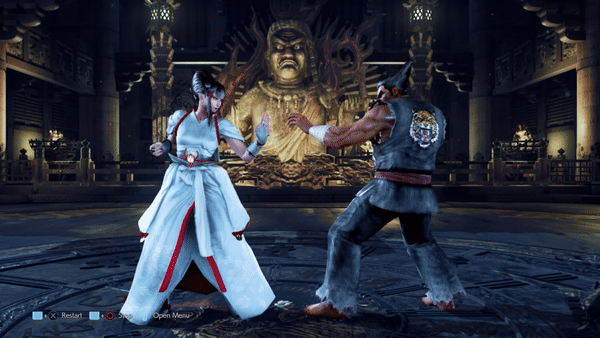
-
Heihachi's 2 is 0 on block. This means that if blocked, any follow-up move will trade with Kazumi's move, as long as both moves have the same start up frames (are as fast as each other).

Calculating start-up during plus and minus frames
Being in plus frames does not guarantee that your follow-up moves will connect before your opponent, and being in minus frames does not guarantee that your opponent's follow-up moves will connect before yours. While your moves will come out sooner in plus frames and later in minus frames, the start-up (speed) of the moves will determine who will get hit (if both you and your opponent attack). To illustrate this, Josie Rizal will block Marshall Law's 1 and follow-up with 1, 2, 2 (i10) to counter Law's 4 and 3, 4.
-
The start-up of Law's 4 is i11. Josie blocks his 1, leaving him at +1;
his 4 will come out 1 frame sooner than Josie's 1 (i10), which means they will trade hits.
Summary:
- The start-up of Law's 4 at +1 = i11 - 1 = i10.
- At +1, Law's 4 trades with Josie's 1.

-
The start-up of Law's 3, 4 is i12. Josie blocks his 1, leaving him at +1; his 3, 4 will come out 1 frame sooner than Josie's 1, 2, 2 (i10), but Josie will still hit Law.
Summary:
- The start-up of Law's 3, 4 at +1 = i12 - 1 = i11.
- At +1, Law's 3, 4 is still beaten by Josie's 1, 2, 2.

Block punishment
Earlier, we pointed out that for most characters, their fastest move is i10 (usually jabs and jab strings). This means that in most cases, a move that is -10 or less on block is unsafe, while a move that is -9 or more on block is safe.
All characters have moves that act as punishers at different frames on block; punishers that are i12 or slower generally deal a good chunk of damage, while i15 and i16 punishers are usually launchers that can be followed up with a combo.
All characters also have while standing (WS) punishers to punish low attacks. Most lows are punishable by i11 WS punishers, while stagger lows are always launch punishable (WS launchers vary in speed between characters, but are usually i14 to i18 in start up frames).
We will use Lili De Rochefort and Leo Kliesen to illustrate these various situations.
-
At -9 on block, Leo's u/f+3 is safe against Lili. Leo cannot be punished after the move is blocked.

-
At -10 on block, Leo's SS 1+2 is unsafe and can be punished afterwards by an i10 move such as Lili's 1, 2.

-
At -12 on block, Leo's 1+2 is unsafe and can be punished afterwards by any move i12 or quicker, such as Lili's 1+2.
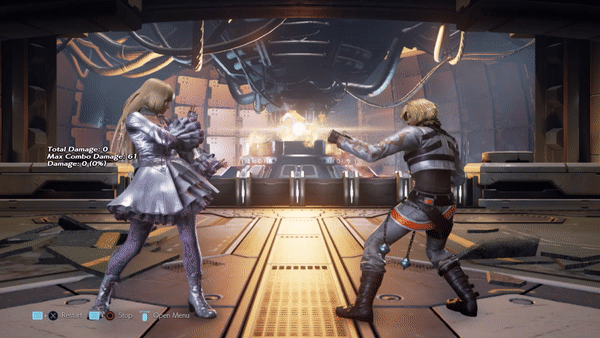
-
At -15 on block, Leo's b, f+1+2, 1+2, 2 is launch punishable. She can be punished afterwards by an i15 launcher, such as a hopkick like Lili's u/f+3.
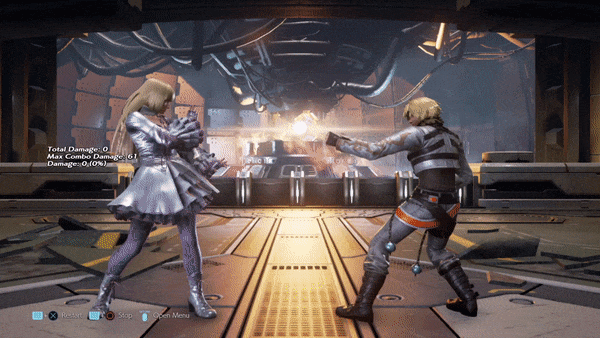
-
At -11 on block, Leo's d+4 is an unsafe low that can be punished by an i11 WS move, such as Lili's WS 4.

-
At -31 on block, Leo's d/b+4 is a stagger low (blocking the move staggers Leo) that is extremely unsafe. She can be punished by a WS launcher, such as Lili's WS 2.
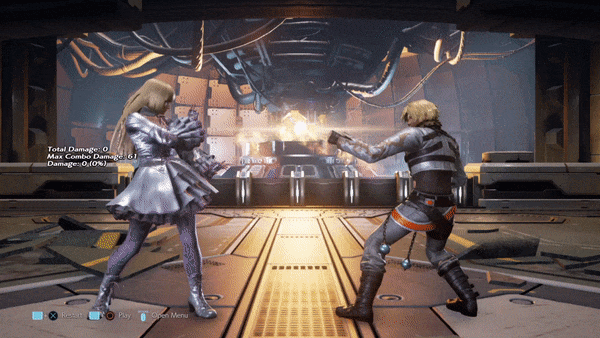
In Tekken, there are multiple characters each with a vast number of moves, each one with their own unique properties, so one must be patient and inquisitive in learning how to deal with each individual character. However, there are certain general situations one will come across that can be dealt with in the same way, regardless of the opposing character. It is useful to familiarise yourself with these as you expand your knowledge on each character's frame data.
General punishment guidelines
-
Most lows in the game are -11 or less on block. Be sure to learn your character's i11 WS punish (WS 4 for most characters) and get that extra bit of damage whenever you block a low.
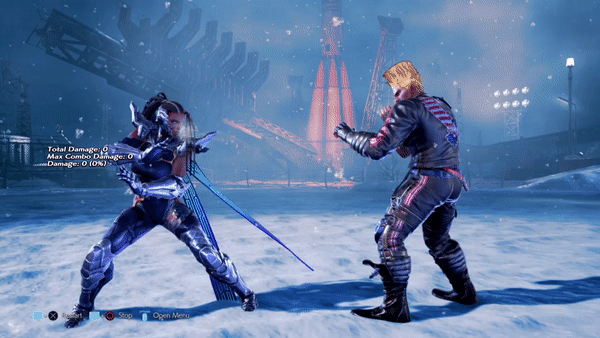
-
All stagger lows are launch punishable. If you happen to block a stagger low, make your opponent pay dearly by launching them and following up with a damaging combo; such lows are so unsafe they can even be punished by rage arts (all of which are i20 or quicker).
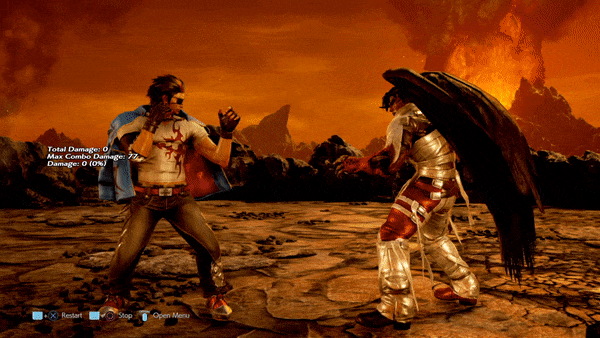
-
Most hopkicks and hop-knees in the game are -13 on block. Don't let your opponent get away with them; find out your character's i10-13 punishers and take advantage of a blocked hopkick or hop-knee for some extra damage.

-
Most rage arts in the game are launch punishable mids. If you're not caught pressing buttons, block the rage art and finish off your opponent with a launcher followed by a combo.
-
Eight characters in the game have rage arts with properties different to the usual:
- Hwoarang's rage art is a safe mid that cannot be punished.
- Lucky Chloe's rage art is a launch punishable low. Be sure to duck and punish when you see it coming.
- Alisa, Anna, Jin and Steve's rage arts are safe highs. Be sure to duck and punish when you see them coming.
- Geese has 2 rage arts: the first (Rashomon) is an unblockable high that must be ducked, while the second (Deadly Rave) is a launch punishable mid like most rage arts.
- Akuma's rage art consists of several unblockable mid throws. Be sure to jump (and punish) when you see it coming.
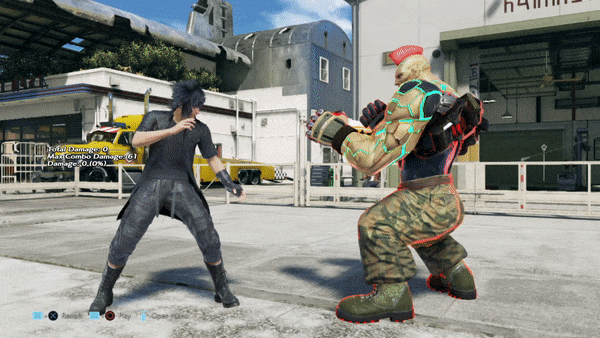
If you would like to check out the frame data for a particular character, we recommend visiting RBNorway.org, which has frame data for every character in Tekken 7 and Tekken Tag Tournament 2. If you'd like frame data on your phone, you can also download the T7 Chicken Plus app, which is available for Android and iOS on their website.
Be sure to consult our notation chart to help you understand the various properties shown in the frame data for each move.





